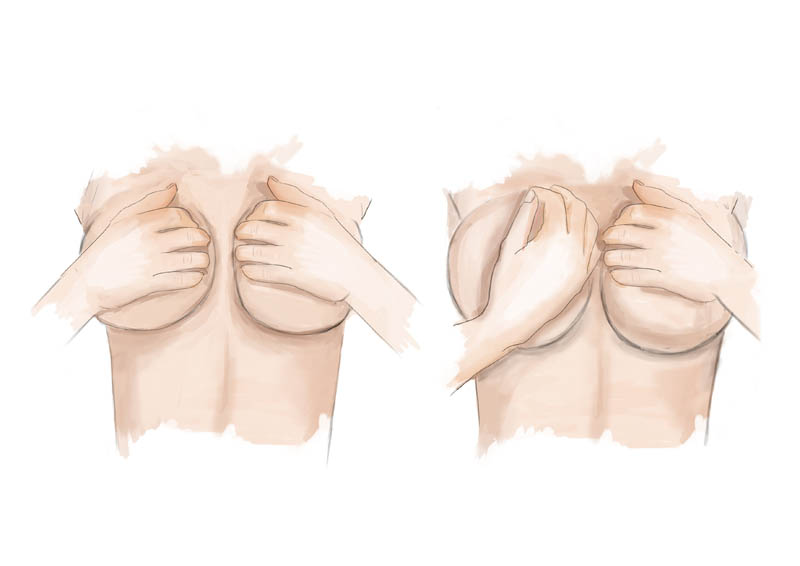
What is Breast Augmentation?
Breast augmentation, sometimes referred to as a "breast aug" or "boob job" by patients, involves using breast implants or fat transfer to increase the size of your breasts. This procedure can also restore breast volume lost after weight reduction or pregnancy, achieve a more rounded breast shape or improve natural breast size asymmetry.
Breast augmentation is also referred to as augmentation mammoplasty. When fat from another part of the patient's body is used to create the improved breast volume, the procedure is referred to as fat transfer breast augmentation.
What Breast Augmentation surgery can do
- Increase fullness and projection of your breasts
- Improve balance of breast and hip contours
- Enhance your self-image and self-confidence
Breast implants may also be used for breast reconstruction after mastectomy or injury.
What Breast Augmentation can't do
Breast augmentation does not correct severely drooping breasts. A breast lift may be required along with a breast augmentation for sagging breasts to look fuller and lifted.
Breast lifting can often be done at the same time as your augmentation or may require a separate operation. Your plastic surgeon will assist you in making this decision.
Breast Augmentation Cost
The average cost of breast augmentation surgery is AU$5,500.
The average cost for removal of breast implants was AU$2,000.
If you are a breast augmentation candidate, please remember that costs can vary.
A surgeon's fee for breast augmentation surgery may vary based on his or her experience, the type and cost of breast implants used, as well as geographic office location.
Many plastic surgeons offer patient financing plans for breast augmentation surgery, so be sure to ask.
Breast Augmentation costs may include:
- Anesthesia fees
- Surgical facility cost
- Medical test
- Post-surgery garments
- Prescriptions for medication
- Surgeon's fee
Breast Augmentation and Health Insurance
Most health insurance plans will not cover cosmetic breast augmentation costs, related complications or another surgery to revise the appearance of your breasts.
Some carriers even exclude breast diseases in patients who have breast implants.
Carefully review your health insurance policy before having your breast augmentation.
Breast Augmentation Candidates
Breast augmentation is a deeply personal procedure, and it's important that you're doing it for yourself and not for someone else, even if that person has offered to pay for it. Patient satisfaction is high, specifically when they want the procedure themselves.
You may be a candidate for breast augmentation surgery if:
- You are physically healthy and you aren't pregnant or breastfeeding
- You have realistic expectations
- Your breasts are fully developed
- You are bothered by the feeling that your breasts are too small
- You are dissatisfied with your breasts losing shape and volume after pregnancy, weight loss or with aging
- You are unhappy with the upper part of your breast appearing "empty"
- Your breasts are asymmetrical
- One or both breasts failed to develop normally or have an elongated shape
If you're considering surgery, spend some time reviewing breast augmentation photos and learning about what to expect during recovery. Preparation ahead of time helps patients have reasonable expectations and a smoother recovery.
Breast Augmentation Recovery
During your breast augmentation recovery, your breasts will be wrapped in gauze dressings and an elastic bandage or support bra will minimize swelling and support the breasts as they heal.
Immediately after surgery, you will be taken into a recovery area for close monitoring. You may be permitted to go home when you are stable for discharge, typically after an hour or so.
Before leaving, you will be given specific postoperative instructions for your breast implant recovery and a follow-up appointment with your plastic surgeon. You may also receive medications or a prescription, but many plastic surgeons prescribe postoperative medications in advance. Your prescribed medications may include pain pills and an antibiotic to prevent infection.
Wear your support garment (a bra or elastic band, called a bandeau) around the clock as instructed by your plastic surgeon. Some surgeons may ask patients cleanse the incision sites and apply ointment, while others will ask their patients to keep tape or a bandage on. Instructions vary, so it's important to follow all your plastic surgeon's directions carefully.
Because it is possible to bleed into the pockets around the breast implants for the first several days, take it easy until you have permission to increase your activity level. Acute pain typically subsides after one to five days, but you may experience soreness and swelling for a few weeks. Resume exercise and normal activity according to your plastic surgeon's directions.
Breast Augmentation Result
While a breast augmentation yields larger breasts right away, the final results may take a few weeks as the swelling subsides and the skin stretches. Some patients may need to wear a bandeau to help shape their breasts, especially if they have underlying asymmetry or very small breasts to start with. Incision lines may take several months, even a couple of years, to fade.
To achieve optimal breast augmentation results, follow your surgeon's post-operative instructions and return for follow-up visits.
Breast Implant Replacement
Breast implants are not considered to be lifetime devices, and they may need to be replaced. You can see your plastic surgeon for an annual examination to evaluate your breast health and implant integrity.
Over time, your breasts will change due to aging, weight fluctuations, hormonal factors and gravity. As the appearance of their breasts changes with time, some patients have a breast lift or an implant exchange to restore a more youthful contour.
